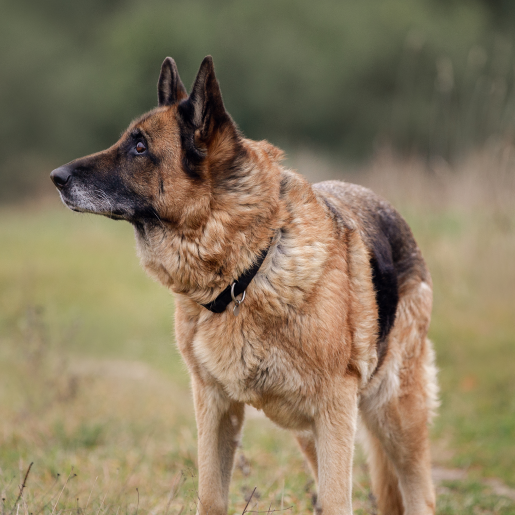Overview
Degenerative myelopathy (DM) is a progressive neurodegenerative disease that affects the spinal cord in dogs. It leads to a gradual decline in coordination, muscle strength, and limb function over the course of months to years, as the spinal cord slowly deteriorates.
Causes
Degenerative myelopathy is caused by a genetic mutation in a gene called SOD1, which normally helps protect cells from damage. When this gene doesn’t work properly, it leads to the gradual degeneration of the spinal cord. This disease shares similarities with ALS (Lou Gehrig’s disease) in humans.
Degenerative myelopathy is an inherited condition passed down from a dog’s parents. Most dogs that develop DM have two copies of the mutated SOD1 gene. Dogs with only one copy usually remain healthy but are carriers who can pass the mutation to their puppies. Dogs without the mutated SOD1 gene are very unlikely to develop the disease.C
While degenerative myelopathy can affect any dog, certain breeds are more commonly affected. These include German Shepherds, Boxers, Pembroke Welsh Corgis, and Bernese Mountain Dogs.
Clinical Signs
The clinical signs of DM usually appear gradually and affect dogs older than 8 years of age. The condition begins subtly, often with a mild loss of coordination in the hind limbs. At first, this may show up as slight wobbling or dragging of one back leg, but as the disease progresses, both hind limbs typically become weaker and weaker.
Eventually, many dogs will lose the ability to use their back legs entirely. The rate of progression varies from dog to dog, but most pets reach this more advanced stage within six months to a year after the first signs appear.
In the later stages of DM, dogs may also lose control over their bladder and bowel functions, and in some cases, the weakness may begin to affect the front limbs as well.
Despite the significant walking challenges, DM is that it is not considered a painful disease. Generally, dogs remain mentally alert, happy, and maintain their personalities even as their mobility declines.
Diagnosis
There’s no single test that can be used to conclude a dog has degenerative myelopathy but rather a combination of tests and clinical signs.
Because the signs of DM can look very similar to other spinal cord problems, we will often recommend an MRI and possibly a spinal tap. This will help rule out other causes of spinal cord disease.
A genetic test is also an important part of the diagnostic process. A blood test can check for the SOD1 gene mutation that is linked to DM. If your dog has two copies of this mutated gene, they are at higher risk for developing the disease.
In summary, DM is considered the diagnosis when a middle-aged or older dog from an at-risk breed begins to show classic signs, has normal imaging results, and tests positive for the genetic mutation.
Treatment
Unfortunately, there is no definitive treatment for degenerative myelopathy, and no medication has been shown to stop or reverse the progression of the disease. Management for DM is about support, mobility, and comfort.
One of the most important parts of managing DM is physical therapy. Regular, controlled exercise can help keep the muscles strong and joints flexible for as long as possible. Physical therapy doesn’t stop the disease, but it helps delay muscle wasting and can improve mobility.
At-home care is just as important. Using a harness or sling as well as providing non-slip surfaces, like yoga mats or rugs are tools to make it easier for the dog to get around and reduce the risk of injury from falling. Avoiding stairs and helping your dog in and out of the car can also prevent injuries.
Prognosis
The prognosis for dogs with DM is poor due to the progressive and incurable nature of the condition.
On average, dogs will lose the ability to walk within 6 to 12 months after signs first appear. Some dogs may progress more slowly, while others may decline more quickly.
As the disease progresses, dogs will eventually lose the ability to walk, along with control of their bladder and bowels. In these later stages, there is usually a significant decline in quality of life, and many families are faced with the difficult decision to pursue humane euthanasia.
